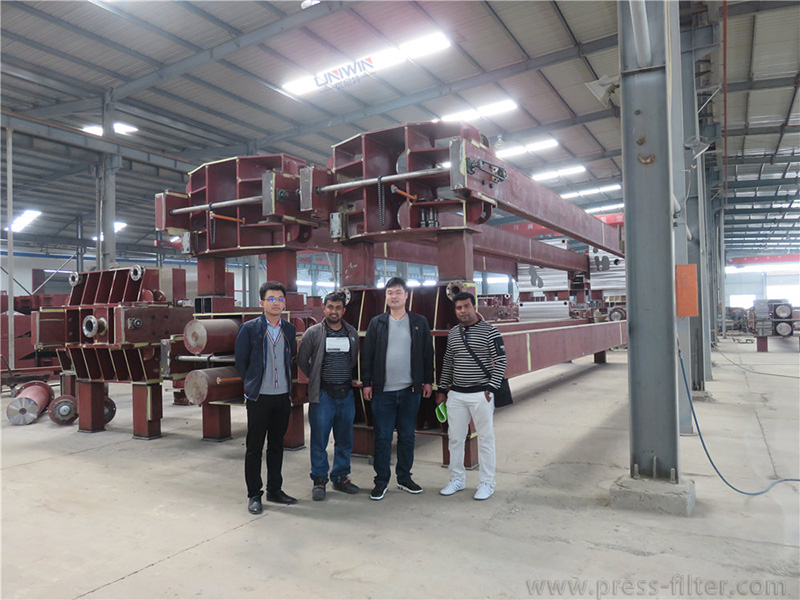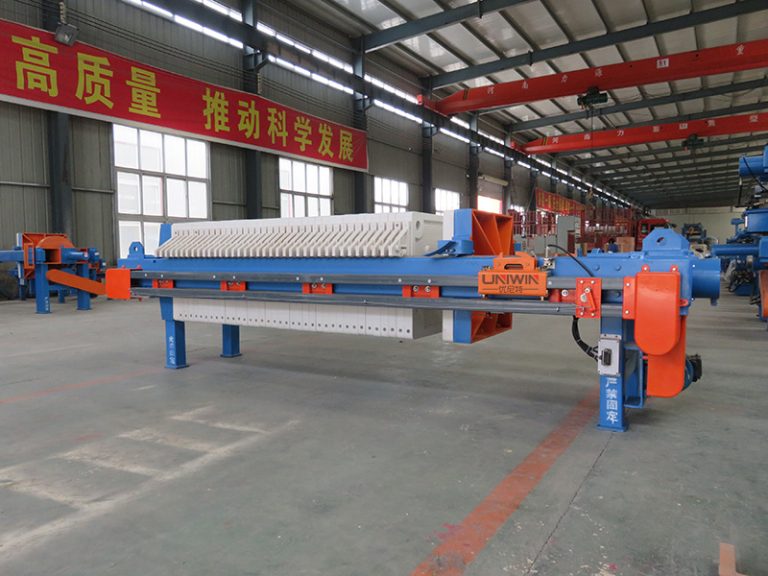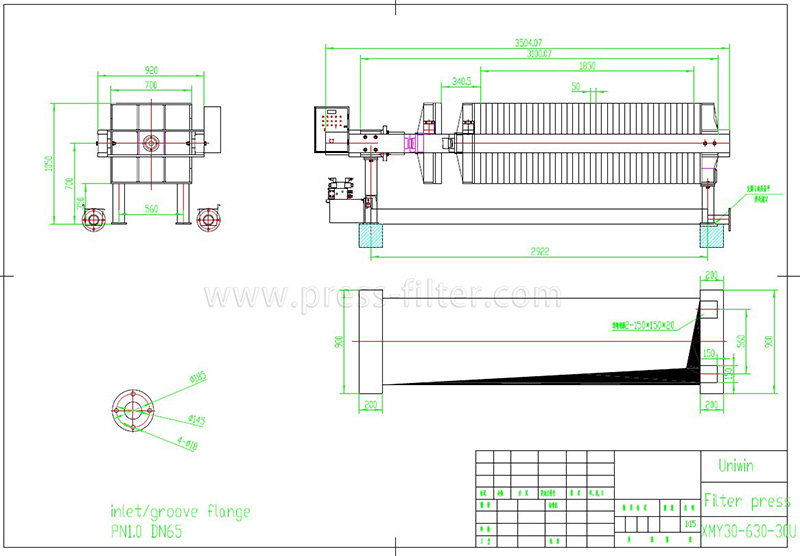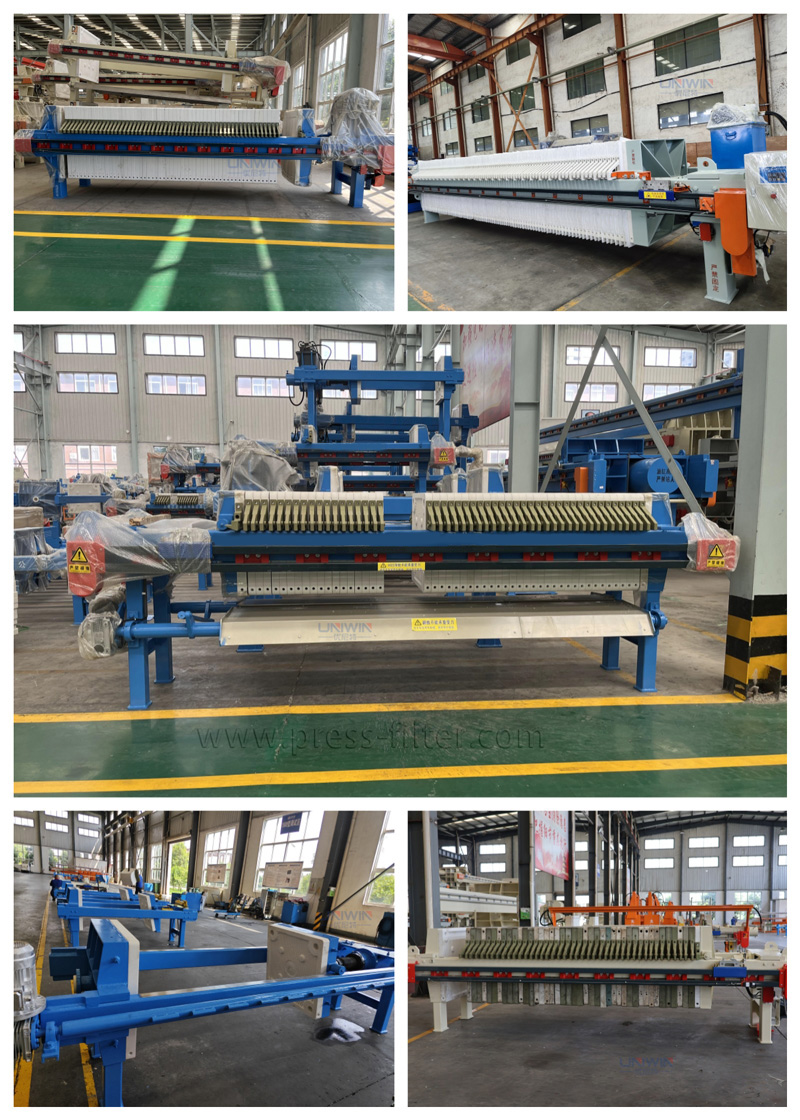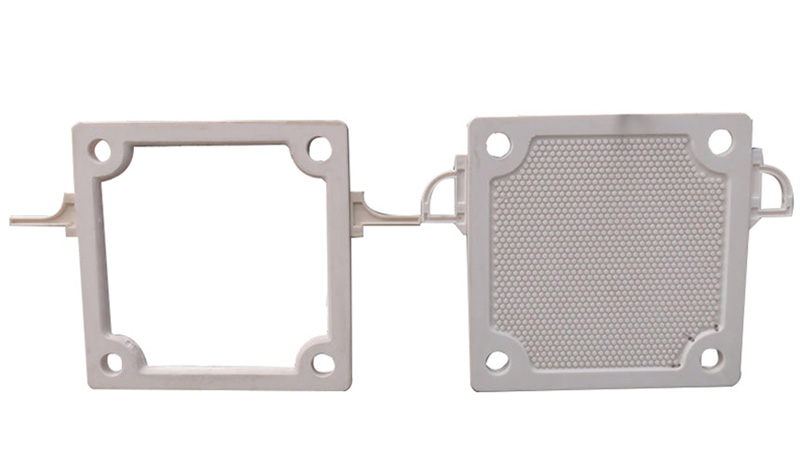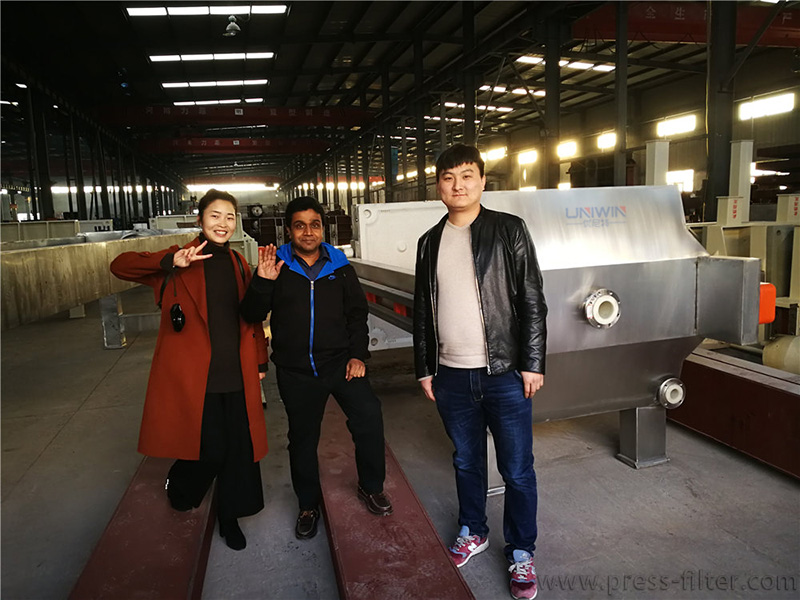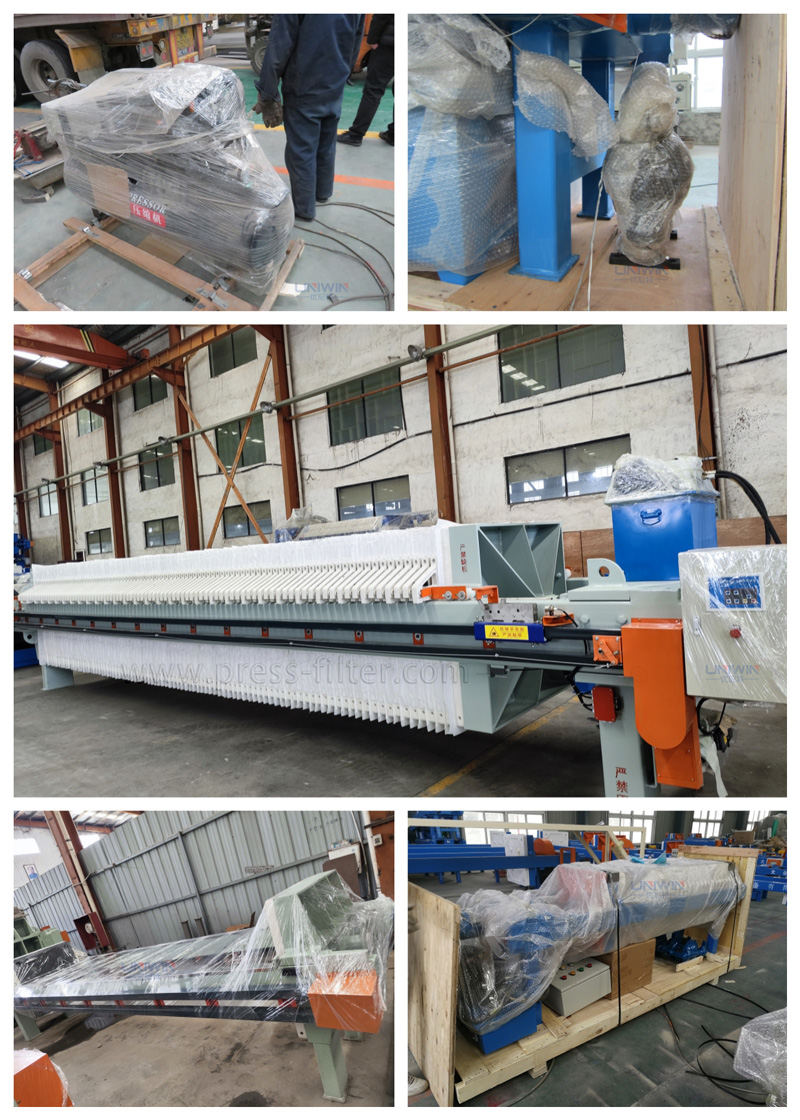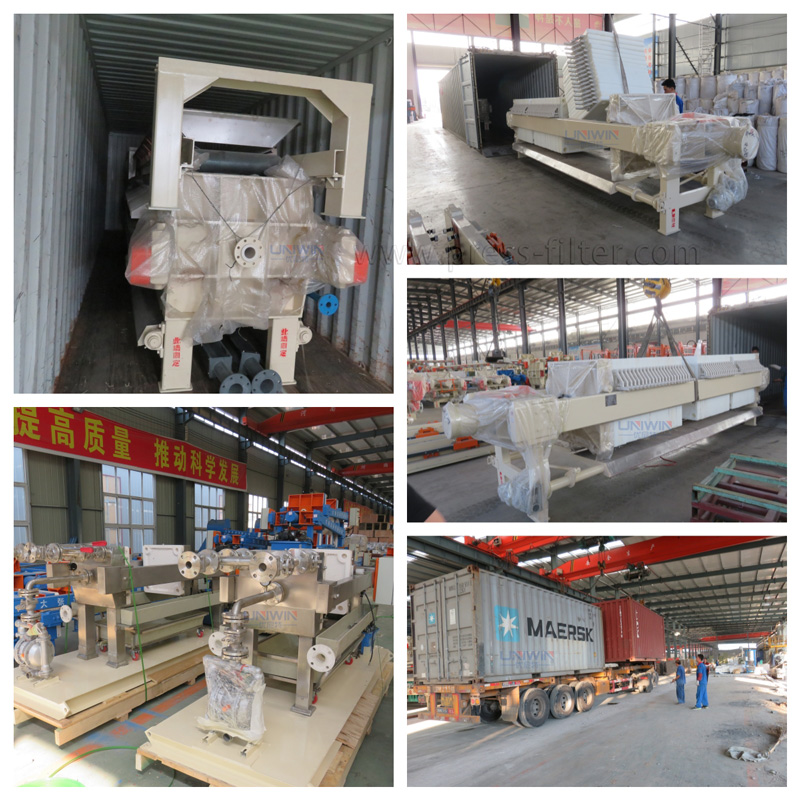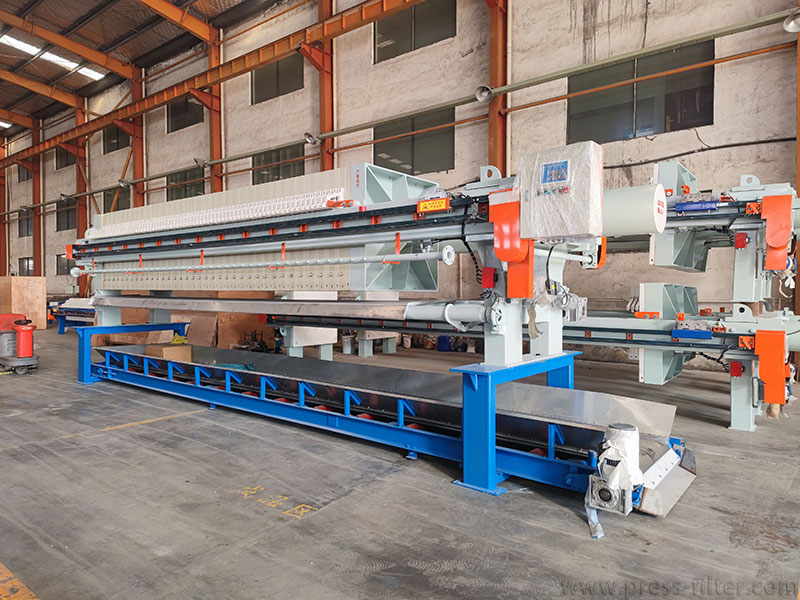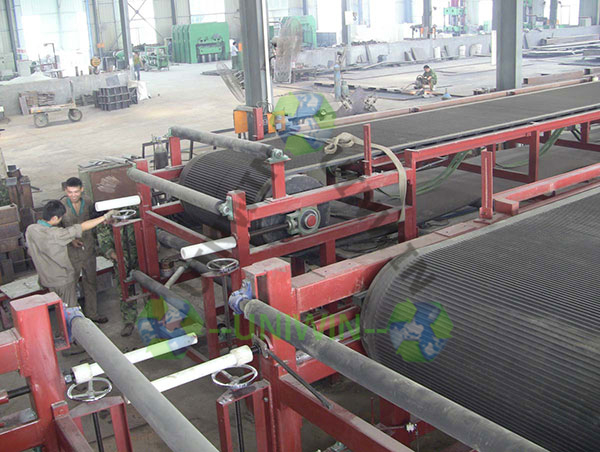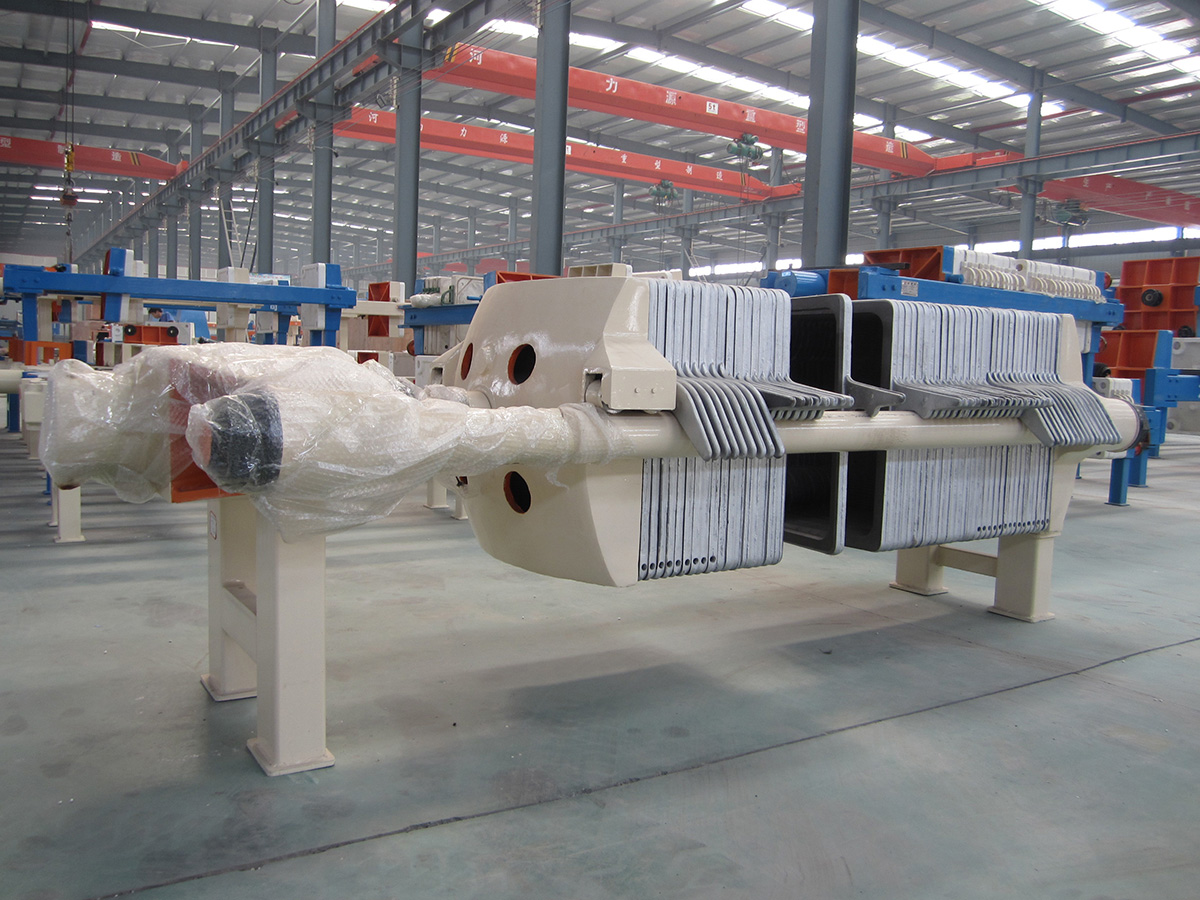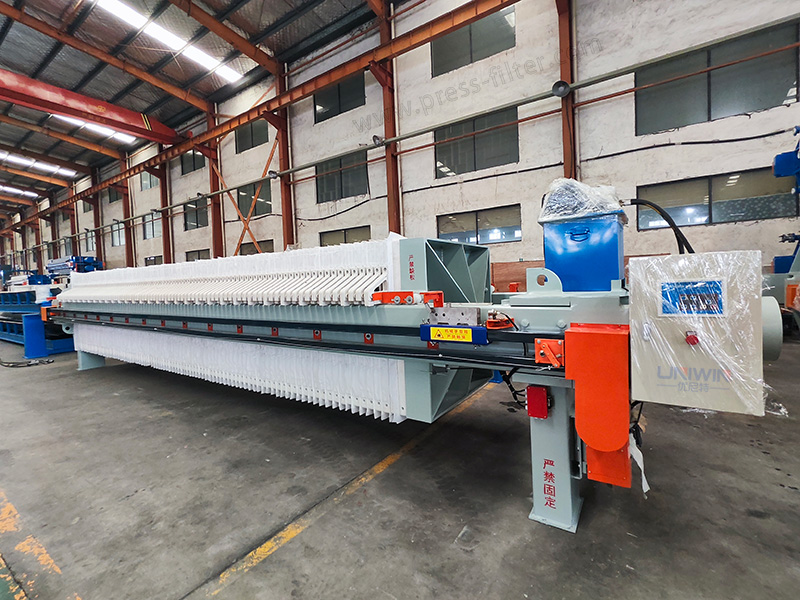Introduction to Plate and Frame Filter Press:
The plate and frame filter press is widely used for solid-liquid separation in various industries. It is known for its versatility and efficiency in separating solids from liquids, making it a popular choice in wastewater treatment, pharmaceuticals, food and beverage processing, and chemical manufacturing, among other applications.
The plate and frame filter press is mainly composed of a thrust plate, a compression plate, a filter plate and a filter frame, a beam, a filter medium (filter cloth), a compression device, a liquid collection tank, etc. The plates and frames are arranged alternately, and the two sides of the filter plates are covered with filter cloth. The plates and frames are pressed tightly by the hydraulic cylinder, and a filter press chamber is formed between the plates and frames. There are holes on the corners of the filter frame and filter plate, which form a complete channel after assembly, which can pass into the suspension, wash water, and lead out the filtrate.
The plate and frame press filter is batch operation, which means that the operation must be stopped to discharge the filter cake before the next batch can be started. The filtering cycle usually takes from 20 minutes to 3 hours, depending on the different characteristics of the filtering material. In contrast, the vacuum belt filter can work continuously. If your processing volume is too large, you can also consider the vacuum belt filter.
Filter Plate and Frame Sizes:
The sizes of our filter plates size are 320, 450, 630,800,1000,1250,1500 and 2000 mm. We can also customize the size of the plates depending on clients’ requirements.
Available Materials of filter plates:
- Polypropylene/PP
- Stainless steel 304 or 316L
- Cast Iron
Plate and Frame Filter Presses Diagram
Plate and Frame Filter Press Working Principle:
The process of one batch filtration is as follows:
1. Closing of the filter plates and frames: when starting the press button on the PLC control cabinet, the moving head plates will be activated by the hydraulic calmps the plates.
2. Filling: The sludge (or slurry) will be pumped into the chamber one by one. When all chambers are full of filter cakes, the filtration is finished.
3. Filter plates and frames opening: The moving head is drawn back to disengage the first filtration chamber. The cake falls will drop from the plates/frames because of gravity. The auto-pulling system pulls out the plates one by one.
4. Filter cloth Washing: Usually, washing of clothes should be carried out every 15-100 batches. A filter press with a filter cloth washing system can greatly improve efficiency.
The automatic plate pulling system and filter cloth washing system mentioned above are additional functions of the fully automatic plate and frame filter press. Compared with ordinary filter presses, the fully automatic filter press can greatly improve efficiency. The automatic pulling plate can pull one or more filter plates at a time to unload the filter cakes, and the filter cloth washing system can automatically clean the filter cloth, significantly reducing time and labor costs.
Detail Photos
Plate and Frame Filter Press VS Recessed Chamber Filter Press
Both the plate and frame filter press and the chamber filter press are commonly used solid-liquid separation devices, yet each offers distinctive features and advantages.
The plate and frame filter press utilize separate plates and frames alternated together, where the frames act as chambers for the slurry to be pumped into, and solids collect on the frame while filtrate passes through the plate. In contrast, the chamber filter press is made up of only recessed plates(without a filter frame), creating built-in chambers between them. Due to this design, chamber filter presses typically have a higher filling capacity than plate and frame types.
While plate and frame filter presses are more suitable for handling thin slurry with a lower solid content, the chamber filter press is preferable for thick slurry with higher solid content due to its larger cake-holding capacity. The choice between the two ultimately depends on the specific application and the properties of the slurry to be processed.
The recessed plate filter press can also bear a higher feeding pressure than that of the plate and frame filter press.
6 Factors that Affect Filtering Cycle
- The thickness of the filter chamber: The thicker the filter chamber, the slower the feeding and filling, so the filtration time is longer.
- Feed pump: Feed pump pressure is closely related to filtration time. A pump with higher pressure can reduce filtration time.
- Filter plate pulling speed: The filter plate pulling speed depends on the hydraulic device and the filter plate moving device.
- Filter cloth: The density of the filter cloth can also affect the filtration cycle.
- Slurry: The density and composition of the slurry will affect the filtration efficiency.
- Flocculant or supporting agent: Flocculant or supporting agent can help filter the slurry better.
How to Shorten Filter Cycle Time
- Choose a filter plate with appropriate thickness, and do not make the filter chamber too thick.
- Choose an appropriate feed pump according to the material, and try to choose a pump with high feed pressure.
- The size of the hydraulic cylinder affects the moving speed of the filter plate. It is important to choose the appropriate size. At the same time, an automatic plate-pulling system can be installed to improve efficiency.
- Select the filter cloth with the best density according to the dehydration characteristics of the material. When the slurry is very difficult to dehydrate, flocculants or supporting agents can be added to reduce the filtration time.
Parameters
| Model | Filter area(m2) | Plate size(mm) | Cake thickness(mm) | Filter chamber volume(L) | Number plate(pcs) | Filtration pressure(Mpa) | Motor power(KW) | Weight(KG) | DimensionsL*W*H(mm) |
|---|---|---|---|---|---|---|---|---|---|
| BMY4/450-30U | 4 | 500*500 | 30 | 60 | 9 | ≤0.6 | 2.2 | 860 | 1950*700*900 |
| BMY6/450-30U | 6 | 91 | 14 | 910 | 2200*700*900 | ||||
| BMY8/450-30U | 8 | 121 | 19 | 960 | 2450*700*900 | ||||
| BMY15/630-30U | 15 | 700*700 | 226 | 18 | 1725 | 2640*900*1100 | |||
| BMY20/630-30U | 20 | 297 | 24 | 1993 | 2940*900*1100 | ||||
| BMY30/630-30U | 30 | 452 | 37 | 2360 | 3590*900*1100 | ||||
| BMY40/630-30U | 40 | 595 | 49 | 2788 | 4300*900*1100 | ||||
| BMY30/870-30U | 30 | 870*870 | 460 | 23 | 2580 | 3330*1400*1300 | |||
| BMY50/870-30U | 50 | 748 | 38 | 3318 | 4260*1400*1300 | ||||
| BMY60/870-30U | 60 | 902 | 46 | 3712 | 4700*1400*1300 | ||||
| BMY80/870-30U | 80 | 1210 | 62 | 4561 | 5580*1400*1300 | ||||
| BMY80/1000-30U | 80 | 1193 | 46 | 5259 | 5120*1500*1400 | ||||
| BMY100/1000-30U | 100 | 1473 | 57 | 5985 | 5800*1500*1400 | ||||
| BMY120/1000-30U | 120 | 1777 | 69 | 6776 | 6500*1500*1400 | ||||
| BMY100/1250-30U | 100 | 1250*1250 | 1468 | 36 | 6728 | 5020*1770*1600 | |||
| BMY160/1250-30U | 160 | 2341 | 58 | 8205 | 6450*1770*1600 | ||||
| BMY200/1250-30U | 200 | 2896 | 72 | 10851 | 7360*1770*1600 | ||||
| BMY250/1250-30U | 250 | 3650 | 91 | 12834 | 8600*1770*1600 | ||||
| BMY300/1500-30U | 300 | 1500*1500 | 5235 | 74 | 25526 | 8130*2200*1900 | |||
| BMY400/1500-30U | 400 | 6985 | 99 | 32074 | 9880*2200*1900 | ||||
| BMY500/1500-30U | 500 | 8735 | 123 | 38106 | 11560*2200*1900 |
